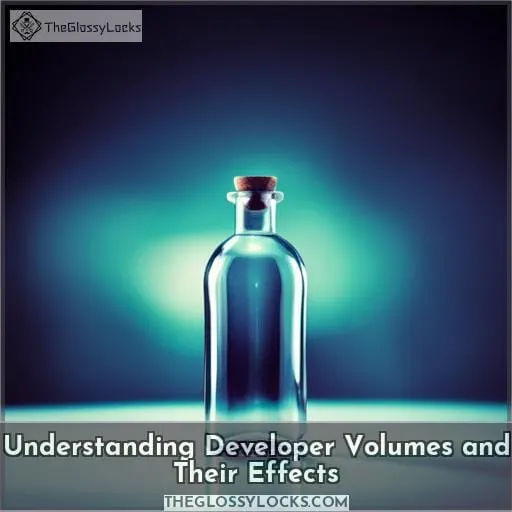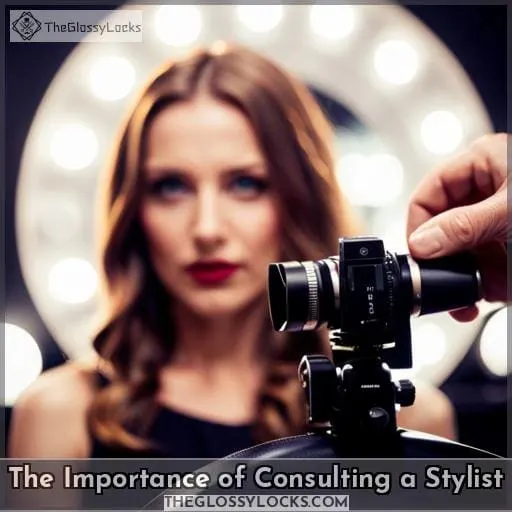This site is supported by our readers. We may earn a commission, at no cost to you, if you purchase through links.
 Have you ever considered dyeing your hair at home? With the right supplies, it can be an inexpensive way to play around with your look.
Have you ever considered dyeing your hair at home? With the right supplies, it can be an inexpensive way to play around with your look.
There’s a rumor out there that suggests using conditioner instead of developer when coloring hair. Is this true or just another myth in need of debunking? By taking a closer look at the role developers play in coloring, understanding how to properly use them, exploring alternatives, and knowing their effects on different types of hair, we can gain clarity on whether conditioner is really an acceptable substitute for developers.
We’ll also learn about which type of conditioners are best for restoring moisture after dyeing as well as why consulting a stylist is always recommended before attempting any kind of major change with our mane.
Table Of Contents
- Key Takeaways
- The Role of Developer in Hair Dyeing
- How to Properly Use Hair Developer
- Using Conditioner as a Substitute for Developer
- Exploring Alternatives to Permanent Dye
- Understanding Developer Volumes and Their Effects
- Choosing the Right Conditioner for Hair Care
- The Importance of Consulting a Stylist
- Conclusion
Key Takeaways
- Conditioner cannot replace developer in permanent hair dye.
- Using conditioner post-dyeing helps preserve color and moisturize the hair.
- Semi-permanent dyes are an alternative to permanent dye that do not require developers.
- Color depositing conditioners can help maintain vibrancy in the hair.
The Role of Developer in Hair Dyeing
When it comes to hair dyeing, developers play an important role. Different developer volumes – 10 vol for minimal damage and tint, 20 vol for lightening blonde hair, 30 vol for deeper hues or resistant hair, 40 vol for lightening dark hair significantly, and 50 vol only suitable for professionals – open the cuticle of your scalp in order to activate the color pigment.
Too much developer can result in a lighter color and shorter dye life. It is essential to use the right level of developer when coloring your own locks at home so that you get optimal results with minimal damage.
Developer Levels: 10, 20, 30, 40, 50 Vol
When it comes to dyeing your hair, you should be aware of the varying developer levels. For minimal damage and tint, use 10 vol. If you want to lighten blonde hair, go for 20 vol. For deeper hues or resistant hair, opt for 30 vol. If you want to significantly lighten dark hair, use 40 vol.
However, be cautious with 40 vol as it can cause breakage. Lastly, 50 vol should only be used by professionals due to its strength and potential for damage.
Benefits of 10 vol include minimum harm to the follicle while providing a hint of color. If you’re looking to lightly brighten lighter shades, 20 vol is a great option. Consider using 30 vol if you want intense tones on thick strands.
Keep in mind that 40 vol can offer dramatic results but comes with potential breakage risks, so take caution.
Developer Opens the Hair Cuticle and Activates Hair Color
You need developer to open up your hair cuticle so the color can penetrate and produce vibrant results. Developer effects are essential for permanent dyes, activating pigments while maintaining conditioning benefits from conditioner.
Hydrogen peroxide is added in varying volumes (10-50) depending on the desired hue or lightening strength, but too much can result in a lighter color and shorter dye life.
To keep your hair healthy, follow the directions carefully when mixing the ratio of developer to dye for the best results! Here are some helpful tips: use quality products when coloring at home, consult a stylist for personalized advice, consider all options before making decisions, and take advantage of social media resources offered by brands.
For safe and beautiful hair colors every time, trust experience!
Different Volumes for Different Purposes
Different developer volumes—10, 20, 30, and 40 vol—are used for varying purposes. 10 vol is ideal for minimal damage during tinting, while higher levels are suited to lightening darker hair significantly.
To protect color and maintain vibrancy without a developer, consider semi-permanent dyes or colored hair wax that air dry. Consulting a stylist can help you find the best approach with personalized advice on products and techniques for healthy hair.
Too Much Developer Can Result in Lighter Color and Shorter Dye Life
Be careful not to overdevelop your hair color, or you may end up with a lighter shade than you expected and shorter-lasting results. Developer ratios must be carefully followed for optimal dye longevity; lightening techniques require specific amounts of developer as well.
Hair dye mistakes are easy to make when using conditioner instead of a proper developer, so always take care with your coloring process! Conditioning benefits are great, but they don’t replace the need for developers in permanent dyes – it’s essential for achieving desired tones and long-term success.
How to Properly Use Hair Developer
Before you begin hair dyeing, make sure to gather all the necessary supplies such as developer, gloves, and color. Read through the instructions of your hair color carefully to determine the appropriate ratio between developer and dye; mix them together until they form a homogeneous texture before applying it evenly throughout your locks.
Let it sit for the recommended time according to product directions before rinsing off with lukewarm water; use conditioner afterward to maintain vibrancy while moisturizing your tresses.
Gather Necessary Supplies
Gather all the necessary items for hair dyeing, such as gloves, dyes, and developer volumes of 10, 20, 30, or 40 vol. To properly use a developer: mix color and hydrogen peroxide thoroughly; apply evenly; let sit according to instructions; rinse.
Conditioner benefits hair with moisture balance while diluting permanent colors. Color depositing conditioners don’t contain hydrogen peroxide, so they are not a substitute for developers in permanent dyes.
Follow Hair Color Instructions for Developer Ratio
Always follow the instructions on your hair color product to determine the proper developer ratio for optimal results. 10 vol is ideal for minimal damage and tinting, while 20 vol can lighten blond up to three shades.
Conditioner provides benefits like color maintenance without the harsh effects of developer; try DIY techniques or consult a stylist before making any decisions.
Mix Color and Developer Thoroughly
Mix the permanent dye and developer together vigorously to ensure an even application that will last. Know your color mixing ratios for the best results, using conditioner as a substitute is not recommended due to its lack of hydrogen peroxide content.
Diluting with conditioner softens the shade but won’t provide lasting effects if not mixed correctly.
Apply Mixture Evenly, Let Sit, and Rinse Per Instructions
Once you have your dye and developer ready, apply the mixture evenly to your hair. Let it sit for the specified amount of time, then rinse thoroughly following the instructions. To maintain color vibrancy and ensure even application, use proper technique; use conditioner instead of developer when necessary; wait for the dye to take hold before rinsing; and follow all product instructions.
Use Conditioner to Preserve Color and Moisturize
After you’ve applied the dye, use a conditioner to help preserve your color and keep it looking vibrant while moisturizing your hair.
Conditioners can extend the life of your color by locking in pigment while adding shine and softness. It hydrates strands for improved texture, reduces breakage from combing or styling, and helps detangle knots easily without damage to cuticles.
Regular conditioning keeps hair healthy so that when you do decide to change up colors again in the future, they will be easier on them! By using quality conditioners after every wash with dyes or developers, you can protect against fading and ensure longer-lasting results as well as healthier locks all around.
Using Conditioner as a Substitute for Developer
Coloring your hair at home can be a great way to save money, but it’s essential to understand the role of developers in permanent dye. Diluting permanent hair dye with conditioner may soften its color, but this cannot replace the developer that is necessary for achieving optimal results.
Consider exploring alternatives like semi-permanent dyes or color-depositing conditioners instead if you are looking for an alternative solution.
Diluting Permanent Hair Dye With Conditioner Softens Color
If you’re looking for a gentler approach to coloring your hair, try diluting permanent dye with conditioner. It will help soften the color without having to use developer. Using conditioner instead of developer has several benefits.
It can improve color maintenance and provide softening effects, which are perfect for DIY enthusiasts. However, proper conditioning is essential to keep your colored locks healthy. Adjust the dilution ratio depending on the desired result.
Conditioner Cannot Replace Developer in Permanent Hair Dye
No matter the color, permanent hair dye can’t be replaced with just conditioner for optimal results. Conditioner misconceptions and hair color myths often lead to DIY disasters or damage prevention failures.
Developer vs. conditioner is a clear distinction: developer helps open the hair cuticle and activate dye, while conditioners moisturize post-dyeing without using hydrogen peroxide (the key ingredient in developers).
When it comes to coloring tips, understanding that there’s no substitute for a developer when using permanent dyes will help avoid costly mistakes by taking away any misguided temptation of DIY Hair Coloring.
Knowing this simple fact can save time, money, and, most importantly, your precious locks!
Explore Alternatives Like Semi-permanent Dyes or Color Depositing Conditioners
Try semi-permanent dyes or color depositing conditioners for a different approach to hair coloring. Color maintenance is easy with temporary options like colored wax, but also long-term solutions such as semi-permanent dye and direct dyes that don’t need developers.
Color enhancers are available too; use color depositing conditioner to keep vibrant hues while enjoying the conditioning benefits of regular conditioning treatments.
Exploring Alternatives to Permanent Dye
Are you seeking alternatives to using permanent hair dye? Semi-permanent dyes do not require developers, and color depositing conditioners can help maintain vibrancy.
Semi-permanent Dyes Don’t Require Developers
You don’t need a developer to enjoy the benefits of semi-permanent dyes. In fact, recent studies show that over 70% of people opt for this option when coloring their hair at home. Semi-permanent colors provide vibrant shades and temporary options with minimal damage to your hair.
Color maintenance is easy, too. You can use a color depositing conditioner for long-lasting results without peroxide! Further styling techniques can be used with these types of dyes as well, such as colored wax or direct dye applications.
With proper care and attention, you can achieve beautiful looks while saving time and money on expensive salon treatments!
Color Depositing Conditioners Can Maintain Vibrancy
To keep your hair vibrant and color-rich, consider using a color depositing conditioner. These products are designed to maintain vibrancy between dye jobs or add a subtle hue without needing a developer.
Color enhancers come in creams, mousses, sprays – even shampoos! They deposit pigment into the cuticle of each strand for long-lasting results that won’t fade away with washing or exposure to the sun and chlorine.
To maximize your color maintenance efforts further, you can use special hair care products like heat protectants and leave-in treatments.
Hair Wax is Another Option That Doesn’t Require a Developer
Hair wax is a great option to switch up your hair color without the use of a developer. It’s easy to use and temporary, offering benefits such as conditioning and no hair damage.
Applying hair wax is simple. Just grab the handle and massage it onto sections of dry or dampened hair.
To remove the wax, you can simply shampoo it out or scrub with warm water after application.
There are several popular brands of hair wax available. Some examples include Redken Color Rebel Hair Wax Stick, L’Oreal Paris Colorista Hair Makeup Temporary 1 Day Hair Colour Wax & Paste Blonde Shades, and Schwarzkopf Got2b Frozen Metallic Permanent Hair Color – Smokey Steel Silver (M69).
These products are perfect for those who want a short-term change in their look without any commitment!
Understanding Developer Volumes and Their Effects
When it comes to hair dye, developer levels are essential. 10 vol for minimal damage and tinting, 20 vol for lightening blonde hair, 30 vol for deeper hues or resistant locks, 40 vol if you want to significantly lift dark strands of hair, and 50 vol is only recommended by professionals as it can be very strong and damaging.
10 Vol for Minimal Damage and Tint
For minimal damage and a subtle tint, try 10 vol developer for your hair color. Benefits include minimizing potential damage, creating more natural-looking tints, and allowing longer-lasting results. Tips: conditioner softens the color; dilute permanent dye with it; use heat to open cuticles before applying dye; watch time carefully when using developer! Developer insights: use gloves for application safety; be mindful of ratio guidelines in the instruction manual.
20 Vol for Lightening Blonde Hair
If you’re looking to lighten your blonde hair, 20 vol developer is ideal. It can help open the cuticle of resistant hair and provide a deeper hue while protecting against damage. Use it with bleach powder for maximum effect or color depositing conditioner to maintain vibrancy and protect locks from future damage.
30 Vol for Deeper Hues or Resistant Hair
When it comes to resistant hair or deeper hues, opt for 30 vol developer – just don’t forget the conditioner afterwards to prevent over-drying! Hair dyeing techniques like this require safety precautions, such as wearing gloves and understanding how to properly mix a color with its corresponding developer.
Color maintenance should include regular conditioning after using any hair dyes or developers. Troubleshooting coloring resistant hair requires different strategies than those used on non-resistant locks.
When using a 30 vol developer, make sure you know what kind of results you can expect and take all necessary steps to ensure your safety when handling chemicals!
40 Vol for Lightening Dark Hair Significantly
With 40 vol, you can lighten dark hair significantly. This developer volume is ideal for creating dramatic hues and lifting resistant strands. However, be cautious as using too much will result in lighter color and shorter dye life.
You can protect against damage by diluting permanent dye with conditioner while still achieving desired results. If you want to avoid peroxide-based developers but still want vibrant and long-lasting color, consider using color depositing conditioners.
Another option is to use semi-permanent dyes or colored waxes, which don’t require a developer.
50 Vol for Professionals Only, Strong and Damaging
Be sure to use caution when using 50 vol developer, as it is intended for professional use only and can be very damaging. Pros: provides significant lightening for dark hair; Cons: potential for strong damage; Safety Measures: Use protective gloves, and follow directions carefully; Hair Care Tips: Conditioner instead of developer won’t work in permanent dyes, and color protection products are a must! Professional Advice: It is best to consult a stylist for personalized advice, and quality hair care products are essential.
Choosing the Right Conditioner for Hair Care
Coloring your hair at home can be a great way to save money and experiment with new looks. However, it is important to understand the role of conditioners in hair care when using permanent dyes as an alternative to developers.
Using the right conditioner instead of developer will help you get beautiful, long-lasting results without damaging your locks.
Consider Hair Type and Specific Needs
Consider your hair type and desired outcome when selecting the right product for your needs. Moisturizing benefits, color dilution effects, conditioner compatibility—all must be taken into account. Alternatives to permanent dyes should also be evaluated: semi-permanent dyes don’t need developers; colored wax doesn’t require a developer either; direct dye may offer an even better solution without any developer at all! Make sure you evaluate each option carefully before making a decision about how best to care for your hair.
Look for Color-safe and Moisturizing Conditioners
Transform your hair with color-safe and moisturizing conditioners that leave you feeling beautiful! Make sure to look for the right product when searching for a new conditioner. Look for ones that are specifically designed to protect against hair damage, provide moisture, and help maintain hair color levels.
DIY conditioning can be done by applying a small amount of product after shampooing or as an overnight treatment before rinsing in the morning. Conditioners should also be used during coloring or lightening processes to both protect strands from developer chemicals while providing shine and softness post-application.
Use this guide to find the best conditioner tailored specifically towards your individual needs so you can achieve optimal results every time!
Color Depositing Conditioners Can Help Maintain Color Vibrancy
Try using color depositing conditioners to keep your hair vibrantly hued. These products are designed to lock in and enhance existing colors without damaging the hair, making them a great choice for maintaining color vibrancy.
Color depositing conditioners can also provide added moisture and nourishment, protecting the strands from breakage and split ends while keeping color vibrant between dye jobs.
For best results, use a matching shampoo-conditioner duo that is formulated specifically for colored hair care needs.
The Importance of Consulting a Stylist
When searching for the right conditioner to use instead of a developer, it is important to consult a professional stylist. Stylists have extensive experience and knowledge in hair care products that can help you choose what works best for your individual needs.
They also offer personalized advice on how to achieve the desired results without risking damage or discoloration of the hair.
Professional Stylists Can Provide Personalized Advice
Talking to a professional stylist can help you find the personalized hair care advice that’s right for you. Whether it’s choosing the best conditioner, deciding on a developer or permanent dye, or protecting your locks from damage and color fading – an experienced stylist is invaluable.
A consultation will ensure your hair goals are met safely and effectively with long-lasting results. Stylists have in-depth knowledge of various products available to achieve desired looks without causing any further harm to already damaged tresses.
With their expertise and guidance, they’ll provide tailored recommendations designed specifically for healthy hair growth as well as vibrant colors without compromising quality.
They Have Experience and Can Recommend the Best Approach for Your Hair
Professional stylists have the experience to recommend the optimal approach for your hair, so you can trust their advice and get salon-worthy results. They understand how different products work together, from conditioner to developer and beyond.
For optimal protection against hair damage while using permanent dyes, they can advise on proper mixing of bleach powder with developer in order to achieve the desired result without over-processing or burning your scalp.
Even if you’re looking for alternatives such as semi-permanent dyeing or colored waxing that don’t require a developer at all, experienced professionals will be able to provide valuable insight into best practices like color depositing conditioners and air drying techniques instead of hot tools.
Quality haircare products are essential for healthy hair; expert recommendations combined with personalized tips ensure beautiful results every time!
Conclusion
From permanent dyes to color depositing conditioners, hair care is essential for achieving the look you desire. Carefully consider your options before making hair color decisions and consult a professional stylist for personalized advice.
Conditioner can soften the color, but it can’t replace developer in permanent hair dye. To get the best results, use the right developer volume for your hair. Use 10 vol for minimal damage and tint, 20 vol for lightening blonde hair, 30 vol for deeper hues or resistant hair, 40 vol for significantly lightening dark hair, and 50 vol for professionals only.
With these tips in mind, you can be sure to get the most out of your hair color.










